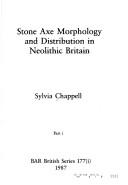| Listing 1 - 5 of 5 |
Sort by
|
Book
ISBN: 1905739907 9781905739905 9781905739837 1905739834 Year: 2014 Publisher: Oxford
Abstract | Keywords | Export | Availability | Bookmark
 Loading...
Loading...Choose an application
- Reference Manager
- EndNote
- RefWorks (Direct export to RefWorks)
Although the copper axes with central shaft-hole from south-eastern Europe have a long history of research, they have not been studied on a transnational basis since the 1960s. What has also been missing, is trying to use as many methods as possible to better understand their production, use and context.
Book
ISBN: 1784917451 9781784917456 9781784917449 1784917443 Year: 2018 Publisher: Summertown, Oxford
Abstract | Keywords | Export | Availability | Bookmark
 Loading...
Loading...Choose an application
- Reference Manager
- EndNote
- RefWorks (Direct export to RefWorks)
"The significant body of stone and flint axe-heads imported into Britain from the Continent has been poorly understood, overlooked and undervalued in Neolithic studies, particularly over the past half century. It is proposed, in this study, that the cause is a bias of British Neolithic scholarship against the invasion hypothesis and diffusionist model, and it is sought therefore to re-assess the significance accorded to these objects. The aim is to redress the imbalance by re-focusing on the material, establishing a secure evidence base, and exploring the probable conditions in which these often distinctive items made their way to Britain. The narrative presented here rests upon the argument that imported axe-heads came into what is today called Britain as objects of considerable significance. Specifically, they were items of high symbolic value that played a crucial role in fostering particular ways of thinking about, and addressing, social identity in the Neolithic period. These issues are the context for the study, whose main objectives are the close and detailed cataloguing of relevant material, and a documentation of the investigative work needed to establish the credentials of each artefact."--
Neolithic period --- Axes --- Tools --- Great Britain --- Antiquities. --- Axes, Prehistoric --- Civilization, Ancient --- Civilization --- Axes, Prehistoric - Great Britain --- Neolithic period - Great Britain --- Great Britain - Civilization

ISBN: 0860544524 9780860544524 Year: 1987 Volume: vol 170 Publisher: Oxford : BAR,
Abstract | Keywords | Export | Availability | Bookmark
 Loading...
Loading...Choose an application
- Reference Manager
- EndNote
- RefWorks (Direct export to RefWorks)
Axes, Prehistoric --- Tools, Prehistoric --- Implements, Prehistoric --- Implements, utensils, etc., Prehistoric --- Prehistoric implements --- Prehistoric tools --- Prehistoric axes --- Great Britain --- Antiquities.

ISBN: 0860544893 9780860544890 Year: 1987 Volume: vol 177 Publisher: Oxford : BAR,
Abstract | Keywords | Export | Availability | Bookmark
 Loading...
Loading...Choose an application
- Reference Manager
- EndNote
- RefWorks (Direct export to RefWorks)
Axes, Prehistoric --- Neolithic period --- Stone implements --- Flint implements --- Lithic implements --- Implements, utensils, etc. --- Debitage --- Prehistoric axes --- Tools, Prehistoric --- Great Britain --- Antiquities.
Book
ISBN: 9781842175965 1842175963 9781842175941 1842175947 9781842174210 Year: 2011 Publisher: Oxford Oakville, Conn. Oxbow Books
Abstract | Keywords | Export | Availability | Bookmark
 Loading...
Loading...Choose an application
- Reference Manager
- EndNote
- RefWorks (Direct export to RefWorks)
This volume builds upon the model of the first Stone Axe Studies volume published in 1979. It explores how scholars from various parts of the world currently approach these distinctive items. Some papers are united by specific material, such as those working on Jadeite axe blades in western and Central Europe. For others, the link is analytical (e.g., the development of new geochemical techniques), contextual (e.g., work on techniques of hafting or on patterns of deposition) or conceptual (e.g., the uses made of ethno-historic and related models). Taken together, they document the state of the
Tools, Prehistoric. --- Axes, Prehistoric. --- Stone implements. --- Flint implements --- Lithic implements --- Implements, utensils, etc. --- Debitage --- Prehistoric axes --- Tools, Prehistoric --- Implements, Prehistoric --- Implements, utensils, etc., Prehistoric --- Prehistoric implements --- Prehistoric tools
| Listing 1 - 5 of 5 |
Sort by
|

 Search
Search Feedback
Feedback About UniCat
About UniCat  Help
Help News
News